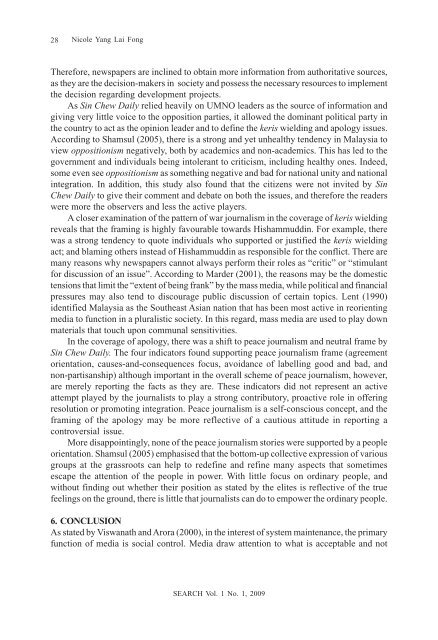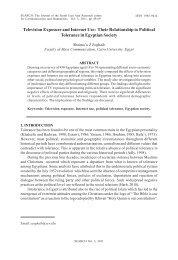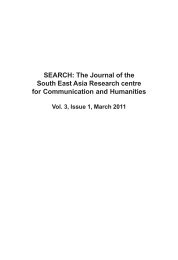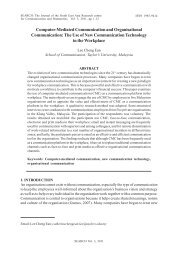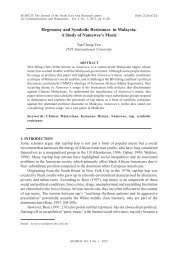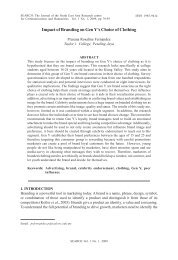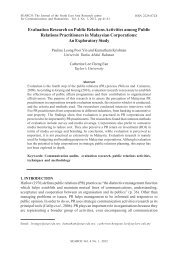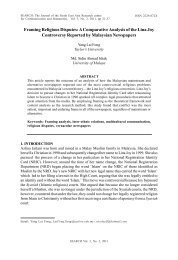Framing Analysis of a Conflict: War/Peace Journalism - Nicole Yang ...
Framing Analysis of a Conflict: War/Peace Journalism - Nicole Yang ...
Framing Analysis of a Conflict: War/Peace Journalism - Nicole Yang ...
- No tags were found...
You also want an ePaper? Increase the reach of your titles
YUMPU automatically turns print PDFs into web optimized ePapers that Google loves.
28<strong>Nicole</strong> <strong>Yang</strong> Lai FongTherefore, newspapers are inclined to obtain more information from authoritative sources,as they are the decision-makers in society and possess the necessary resources to implementthe decision regarding development projects.As Sin Chew Daily relied heavily on UMNO leaders as the source <strong>of</strong> information andgiving very little voice to the opposition parties, it allowed the dominant political party inthe country to act as the opinion leader and to define the keris wielding and apology issues.According to Shamsul (2005), there is a strong and yet unhealthy tendency in Malaysia toview oppositionism negatively, both by academics and non-academics. This has led to thegovernment and individuals being intolerant to criticism, including healthy ones. Indeed,some even see oppositionism as something negative and bad for national unity and nationalintegration. In addition, this study also found that the citizens were not invited by SinChew Daily to give their comment and debate on both the issues, and therefore the readerswere more the observers and less the active players.A closer examination <strong>of</strong> the pattern <strong>of</strong> war journalism in the coverage <strong>of</strong> keris wieldingreveals that the framing is highly favourable towards Hishammuddin. For example, therewas a strong tendency to quote individuals who supported or justified the keris wieldingact; and blaming others instead <strong>of</strong> Hishammuddin as responsible for the conflict. There aremany reasons why newspapers cannot always perform their roles as “critic” or “stimulantfor discussion <strong>of</strong> an issue”. According to Marder (2001), the reasons may be the domestictensions that limit the “extent <strong>of</strong> being frank” by the mass media, while political and financialpressures may also tend to discourage public discussion <strong>of</strong> certain topics. Lent (1990)identified Malaysia as the Southeast Asian nation that has been most active in reorientingmedia to function in a pluralistic society. In this regard, mass media are used to play downmaterials that touch upon communal sensitivities.In the coverage <strong>of</strong> apology, there was a shift to peace journalism and neutral frame bySin Chew Daily. The four indicators found supporting peace journalism frame (agreementorientation, causes-and-consequences focus, avoidance <strong>of</strong> labelling good and bad, andnon-partisanship) although important in the overall scheme <strong>of</strong> peace journalism, however,are merely reporting the facts as they are. These indicators did not represent an activeattempt played by the journalists to play a strong contributory, proactive role in <strong>of</strong>feringresolution or promoting integration. <strong>Peace</strong> journalism is a self-conscious concept, and theframing <strong>of</strong> the apology may be more reflective <strong>of</strong> a cautious attitude in reporting acontroversial issue.More disappointingly, none <strong>of</strong> the peace journalism stories were supported by a peopleorientation. Shamsul (2005) emphasised that the bottom-up collective expression <strong>of</strong> variousgroups at the grassroots can help to redefine and refine many aspects that sometimesescape the attention <strong>of</strong> the people in power. With little focus on ordinary people, andwithout finding out whether their position as stated by the elites is reflective <strong>of</strong> the truefeelings on the ground, there is little that journalists can do to empower the ordinary people.6. CONCLUSIONAs stated by Viswanath and Arora (2000), in the interest <strong>of</strong> system maintenance, the primaryfunction <strong>of</strong> media is social control. Media draw attention to what is acceptable and notSEARCH Vol. 1 No. 1, 2009


